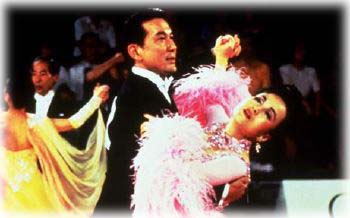![[Metroactive Movies]](/movies/gifs/movies468.gif)
![[Metroactive Movies]](/movies/gifs/movies468.gif)
[ Movies Index | Metro | Metroactive Central | Archives ]
Leading Romance
Ballroom dancing is sweetly ribald in the Japanese film 'Shall We Dance?'
THE JAPANESE sense of reticence, when captured by the right cameras, could give American audiences that same sort of lesson in decorum that British film used to deliver in the 1940s and '50s. Certainly the gentle, wistful Shall We Dance? ought to delight audiences alienated by violence and noise.
Middle-aged Tokyo salaryman Shohei (Koji Yakusho) is very married, with a house and an adolescent daughter. He's half-asleep on the commuter train on his way home when he sees something extraordinary. In the window of a second-floor dance studio, he views a beautiful woman. She stares out at the passing trains with a look of regret on her face. Gathering his courage, Shohei stops by later to investigate and ends up being solicited into ballroom-dance lessons.
As a narrator explains before the titles, Japan is a country where men don't touch their wives in public, so ballroom dancing seems especially ribald. Since Shohei doesn't have a ribald bone in his body, his embarrassment in these lessons is nearly crucifying, and he doesn't dare tell his wife. Moreover, he isn't getting any closer to the woman he had observed.
Her name is Mai (Tamiyo Kusakari), and she's the head sensei (teacher). Mai is as formal after hours as she is during the lessons, but a shy, chaste friendship soon develops between them. Meanwhile, Shohei's neglected wife, wondering what her husband is up to at night, hires a pair of detectives who lead her into the midst of Shohei's secret life.
This Japanese success catches the grace of the old RKO musicals, but it also doesn't spare the gusty humor that made those old films appeal to the flesh as well as the spirit. One can love Rogers and Astaire musicals not just for the dancing but also for character actors Erik Rhodes, Eric Blore and Edward Everett Horton.
Director Masayuki Suo hasn't neglected the physical comedy, especially in a keen joke about the way Shohei and a fellow closeted dancer from work keep meeting in the men's room to discuss their secret hobby. And there is a Helen Broderick figure as well. One of the teachers, a plump, flamboyant widow named Tomoko (Eriko Watanabe), is accustomed to ironing the jitters out of the terrified students; she does not fear the male sex.
Watanabe's performance isn't directly modeled on any of the tough chorines that turned up in RKO and Warner Bros. musicals, but Watanabe does seem to talk out of the side of her mouth just like Joan Blondell used to. At moments, the blocked, shy romance of Mai and Shohei is too much like watching two pairs of stiff upper lips that we know will never kiss, and that's when Watanabe's raised eyebrows and weary smirk rally the film.
Shall We Dance? has a slow first half-hour as Shohei's backbone slowly thaws, but once it gets rolling, the film is fine old-fashioned entertainment. Ballroom dancing still has something of the thrill of close contact with the opposite sex, and Shall We Dance? makes those stylized rituals look a little sexy, as they must have been, once upon a time.
[ Metro | Metroactive Central | Archives ]

Tentative Steps: Hideko Hara and Koji Yakusho practice their moves in 'Shall We Dance.'
Shall We Dance? (PG; 117 min.), directed and written by Masayuki Suo, photographed by Naoki Kayano, and starring Koji Yakusho and Tamiyo Kusakari.
From the July 31-Aug. 6, 1997 issue of Metro.